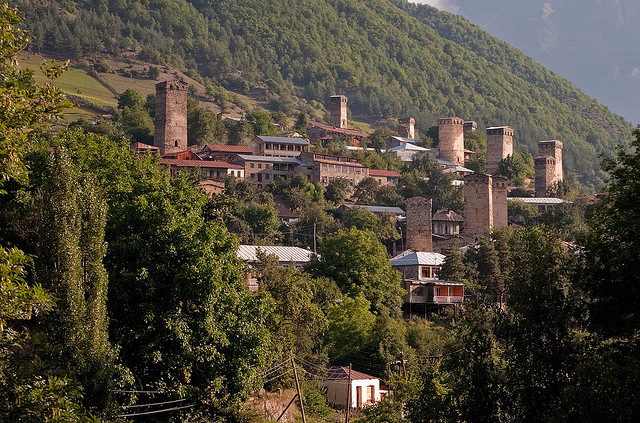Stradding Europe and Asia, the Republic of Georgia has played an important role in history. Warring kingdoms, powerful kings and queens, invading armies, and silk road caravans have all left their marks on Georgia. This country is still rich with traces of the fascinating historical saga that has created modern-day Georgia. Here are just a few of Georgia’s most remarkable historical attractions.

Flickr photo by deguonis
The medieval hamlets of Upper Svaneti have been around for thousands of years, predating the existence of the Kingdom of Georgia. In these villages, time stands still. The stone towers, ancient houses, winding dirt roads, and green hills look much the same as they did when the region was ruled by the Kingdom of Lazikain the 4th century AD, and later by the Abkhaz Kingdom.
Chazhashi village is the best preserved, with nearly 200 towers still standing. The village’s two castles, numerous churches and a museum showcase its medieval heritage. Upper Svaneti’s isolation protected it from foreign domination and influence, and its status today as a UNESCO World Heritage Site continues to protect and preserve it.
While Upper Svaneti’s sleepy stone villages seem to transport you back in time, the Bagrati Cathedral and the Gelati Monastery showcase the grandeur and scale of Georgian architecture at its height. These two monuments to Georgia’s Golden Age are located in the city of Kutaisi. The Gelati Monastery was not only a showcase of medieval Georgia’s architectural and artistic mastery, it was also an important center for education, science, and culture. And although the Bagrati Cathedral currently lies in ruins as the result of a Turkish invasion, it is still possible to see remnants of its impressive architecture and intricate design amidst the crumbled stone.
Like most cities, Georgia’s famous cave cities contain residences and churches, with a few ancient throne rooms and even terraced farming fields and irrigation systems. Here, however, they are all literally carved into the mountainside. The most well-known of these sites, Vardzia, was originally built as a fortress to protect against invading armies. Georgia’s Queen Tamar later founded a monastery there. Another cave city, the sprawling David Gareja monastery complex, was built in the 6th century. It also served dual purposes as a monastery and as a defensive fortress during its long history. Although time and ancient battles have destroyed many parts of the cave cities, there are still areas that are well preserved and are even inhabited to this day.
Medieval villages, grand cathedrals, and cities carved into mountain walls are just a few of the remarkable sites that Georgia has to offer.
You can see all of this and more for yourself! Reach To Teach, in partnership with the Ministry of Education and Science of Georgia is proud to offer teaching positions throughout Georgia. The Georgian government is making English language education one of its top priorities, and they are working to bring ESL teachers to Georgia from all over the world. Participants in this program receive paid flights to and from Georgia, accommodation with a Georgian host family, and a week of culture and language training. In addition to this, you get a stipend of approximately $300USD per month to cover your living expenses.
For more information, visit our website:
http://www.reachtoteachrecruiting.com/teach-english-in-georgia.html or contact Stephanie[at]ReachToTeachRecruiting.com
Don’t pass up this great opportunity to see Georgia’s fascinating history, and to be a part of its future!
Written by Stephanie Long, Director of Recruiting for Georgia, Reach To Teach Recruiting
Feature photo by Pete Johnson, Reach To Teach Teacher in Georgia
